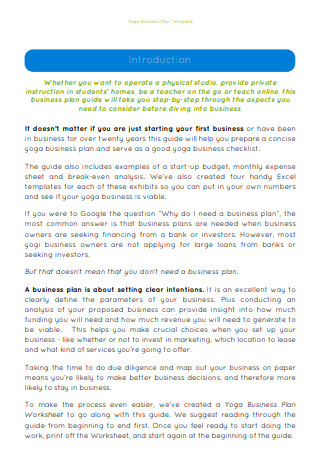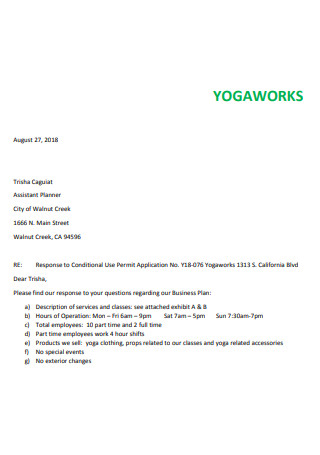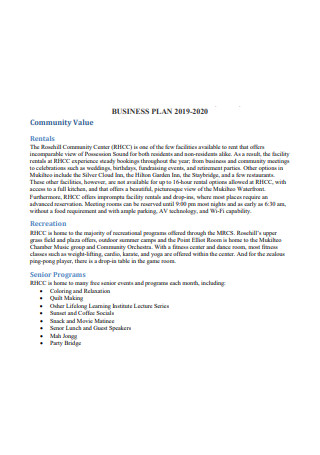8+ Sample Yoga Business Plan
-

Yoga Studio Business Plan Template
download now -

Yoga and Wellness Centre Business Plan
download now -

Sample Yoga Studio Business Plan
download now -

Yoga Business Plan Template
download now -

Bamboo Yoga Play Business Plan
download now -

Sunrise Yoga Business Plan
download now -

Yoga Business Plan Example
download now -

Basic Yoga Business Plan
download now -

Yoga Business Plan in PDF
download now
What Is a Yoga Business Plan?
Let’s start with discussing a business plan in general before getting into what a yoga business plan is. A business plan is a document that plans a company’s primary objectives, business operations, and strategies for achieving those objectives. The layout will vary depending on the intended usage and audience, but it’s essentially a road plan! To reach where we want to go, we need to know where we’re going and at least have a general notion of how to get there. That is why most successful businesses have a business plan—it is essential in making aspirations a reality. While a yoga business plan is similar to any other business plan, one distinction stands out: the typical yogi mindset! A good yoga business is frequently hampered by the yogi who runs it! Research shows that yoga is a significant business in the United States. According to statistics, the average yogi spends $62,640 on lessons, workshops, and accessories over their lifetime, or about $90 per month. They practice regularly, with the majority (44%) going 2-3 times per week, preferably in the morning (34%) or evening (34%) (18 percent ). The financial expenditure does not end there. The average yogi is willing to spend $40 on a one-of-a-kind, once-in-a-lifetime yoga experience. And 6% of individuals are willing to pay more than $100 for a unique yoga session.
Benefits of Using a Yoga Business Plan
A yoga studio business plan is necessary to the success of your business, from assisting you in defining the purpose of your facility to keeping track of costs. You can only measure how well your firm is going and establish new goals for the future by looking at your sales strategy. Here are some of its additional advantages.
How To Create a Yoga Business Plan
You’ve come to the perfect place if you’re a new business owner or want to improve your current yoga studio business plan. The progress of your firm depends on having a solid foundation and a clear set of objectives. Consider your yoga studio business plan to be a compass that keeps you on track and always points you in the right direction. You might as well be lost if you don’t have a good structure for your firm. It’s risky to have a strategy in place to layout your goals and determine what your company wants to accomplish year after year. This aids your understanding of your yoga studio’s ins and outs, as well as your flaws and talents.
Your yoga studio business plan can assist you in determining how to improve and build the most effective techniques for bringing your facility to its full potential. When writing your business strategy, take your time because it requires considerable thought and consideration. If you’re working with a group or a partner, make sure to include everyone’s feedback because everyone has their area of expertise. This is essentially a mirror of your yoga studio, so make sure you’ve covered all bases and consider all factors. The steps of writing a yoga business plan are outlined here.
Step 1: Build a strong foundation.
The initial step in your plan should be to secure your company’s foundation. You’ll be able to accurately articulate and explain what makes your yoga studio unique if you have a precise understanding of its core. A company’s mission statement and vision are its foundation. It’s crucial to know your yoga studio’s purpose and what you want to provide individuals in your community. What challenges will you solve, and how will your facility improve the lives of others? You may start deciding how to attain your business’s vision once you’ve clearly expressed these factors. After that, give a thorough explanation of your business.
How did your business begin, and how long has it been in operation? Is your yoga studio dedicated to a single form of yoga, or do you offer various classes? What services do you have to offer? What makes your studio’s services stand out? You can highlight the most important aspects of your facility by answering all of these questions. Finally, a solid foundation would be incomplete without an explanation of how your studio differs from others. What distinguishes you from others? What new service will you provide to your members? This requires excellent consideration because you want to ensure that your yoga studio is unique. With a well-thought-out yoga studio business plan, you can pinpoint what sets your facility apart.
Step 2: Set goals and objectives.
You can begin to build on your yoga studio’s foundation by creating goals and identifying your aims now that you’ve done the groundwork. You must explain the direction you want to take your facility, whether you are developing a one-year or five-year plan. As you outline your road to success, this section of your business plan is critical. It’s vital to ensure that the objectives you set are attainable. When selecting your goals, keep in mind that your yoga studio can be brand new and just getting started. Make sure your objectives are specific. You won’t be able to measure your goals if they’re too broad, such as obtaining a high client retention rate.
You may quantify your progress year after year if you are meticulous. It’s critical to set new goals once you’ve met your previous ones. When running your own company, there is no such thing as a good finish line. With each plan you achieve, your yoga studio should expand and evolve to new heights. Your facility will stagnate if you stop setting goals and become too comfortable with your current status, so always consider the next major challenge and how you’ll overcome it.
Step 3: Give an overview of your management staff.
Another important part of your yoga studio business plan is a description of your management team, especially if investors will be looking at it. Provide a summary of each of the persons participating in your company. Include your job title, previous experience, and previous accomplishments while writing this section. Would you please demonstrate that you have the correct individuals on board to help you operate your company and that their knowledge is valuable? It is also essential for all employees to understand their job titles and responsibilities. There will be less uncertainty and more clarity regarding running an efficient business if everything is written down and out in the open. Consider setting a deadline for when you’d like to have all of your employees on board and make hiring the ideal team for your yoga studio a complete focus.
Step 4: Create a marketing strategy.
Now you must devise a marketing concept for your yoga studio. This necessitates market research so that you may learn about your competition and the finest approaches to promote your facility. To begin, you must know about your target audience. What kind of people do you want to promote your yoga studio too? Consider your consumers’ age, demography, region, occupation, and any problems they may have. Then, start planning how you’ll reach out to them and let them know about your yoga studio. This can be done in different methods, including email marketing and social media use. Email marketing is an efficient way to advertise your business, so establish a list of all of your current clients’ email addresses. Send them monthly emails to keep them up to date on what’s new at your studio and any special offers you’re running.
Another effective advertising strategy is social media, which puts you in direct contact with your clients and potential members. Everyone is online these days, so join them and take advantage of this free advertising space! Create engaging posts to attract your target audience’s attention and keep them engaged by releasing new content frequently. It’s also critical to understand your industry’s rivals while creating a marketing strategy. Who are they, and what sets your studio apart from theirs? This is also an excellent approach to learn about the strengths and shortcomings of your studio about others. You’ll be able to design intelligent techniques to set your studio unique and rise above the competition by analyzing these elements!
Step 5: Prepare a cash flow statement as well as revenue forecasts.
A cash flow statement and revenue projections must be included in your yoga studio business plan to estimate the amount of money you’ll need to keep your firm afloat and your projected earnings in the future. This will assist you in having a record of your facility and determining its success. Cash flow statements help you keep track of how much money is coming in and going out of your business. How much do you consume to keep your facilities in good working order? Being aware of such expenditures can help you keep your yoga studio afloat by ensuring that all expenses, such as rent, employee pay, and amenities are covered.
This component should also include capital expenditures, which are the funds you invested in the start-up of your yoga studio. Keeping track of these records will assist you in managing your financial costs and profit loss over time. Revenue forecasts are also an essential component of any yoga studio business plan. This is the amount of money you anticipate your company making month after month, year after year. Also, this can help you set goals and make adjustments to your firm to increase income and return on investment.
Step 6: Invest in management software for your company.
Consider including a part in your yoga studio business plan about investments you are willing to make to bring your firm to success when analyzing costs and efficiency. For example, why not invest in effective business management software that will help you streamline your facility? Not only can we assist you with such duties, but we can also use our automated marketing solutions to boost the popularity of your studio!
FAQs
How much does starting a yoga business cost?
It all depends on your business! The expense of starting a brick-and-mortar yoga facility is much more than that of a pop-up class. Alternatively, if you wish to offer online yoga lessons and have an extensive email list, your startup costs may be restricted to management software and an internet platform. Here’s where your business plan comes in handy! If the financial investment isn’t aligned right now, pivot and see if there’s a way to make your business exist more cost-effectively as you investigate your goal and vision and get honest about the potential costs.
Is Yoga A Successful Business?
It’s possible! There are more opportunities for yoga teachers than ever before, and you have plenty of room to be creative with your yoga service! You can perform the bare minimum and get paid for it, or you can be passionate about teaching yoga while also living your best life. I lead you through two major areas of making what you want from your yoga company in my advanced yoga course (hint: the math and your thoughts). We figure out how to make $100k as a yoga instructor by calculating how much you need to earn per student. You might sell a single high-priced item or a large number of low-cost items! Research shows that a yoga studio owner’s average gross monthly income is $7,227, or $86,000 per year. The average monthly revenue for a yoga studio is 13,495 dollars. After the owner deducts expenses like rent (15 percent on average) and teacher compensation, the income is left (27 percent on average).
Why do so many gyms fail?
“The most significant issue we find for health club failure, aside from being under-capitalized, is a lack of business know-how and adequate implementation of sales and marketing strategies,” says Thomas. “Another prevalent misunderstanding among novice gym owners is that their facility would sell itself.”
A yoga studio business plan is essential to the success of your business because it helps you define the exact purpose of your facility and allows you to keep track of important things. Only by examining your plan can you determine the success of your business and set new goals for the future. This is not to say that all details will always be specified. Running a business is fraught with ups and downs, and things do not always go as planned. Remain optimistic when times are tough and humble when times are good. If you remain adaptable and go with the flow, your business will endure.
